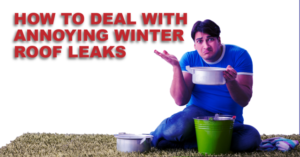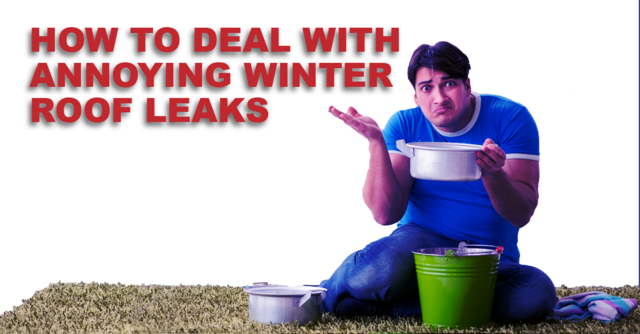
There is an internet chart that shows chances of snowstorms for Minneapolis, 2019-2020. Beginning in December 2019, there is a possibility of a snowstorm every day through February 2020. Last year we got 71″.
One of our local emergency ice dam removal companies did the math and determined 1¾ inches of snow weighs about as much as a compact SUV parked on your roof. That’s a lot of snow. It’s no wonder winter is the time of year when we discover roof leaks.
5 Signs of Winter Roof Leaks
Snow and ice storms are one of the main causes of winter roof leaks, particularly here in the Midwest. You could have a tiny leak. It goes away, so you think it was a fluke. A few weeks later…there it is again. That tiny leak could indicate a big problem.
Other signs of winter roof leaks include:
- Drip(s) – It doesn’t matter when you see a ceiling drip, it’s a red flag. On a warmer, sunny day, ice build-up can thaw. The melted water can get underneath shingles and then freeze again at night. Your roof can spring a big leak, even though you only see a small drip.
- Exterior mold – Mold or mosses growing on an exterior wall of your house could be because the wall is in a shaded area. Or it could mean a problem with your roof’s gutters or downspouts. Gutters catch and direct melted snow to your home’s downspouts.
- Exterior roofline stains – Water spots on your outside walls, especially just below where your roof meets the walls, can indicate a roof flashing problem. “Flashing” is a thin metal material roofers use to route water away from vulnerable areas. It’s installed anywhere the roof surface meets a vertical plane (like a chimney, a skylight, vents, and walls).
- Missing shingles – Missing shingles aren’t an emergency situation, but you need to schedule an inspection with your local roofing professional as soon as possible. Roof shingles are protection for your home. When they are damaged, the likelihood of a leak increases.
- Stain(s) – You can barely see the yellowish splotch on your ceiling. It’s in a dark corner. It’s ringed with brown. And even though it’s barely noticeable, it’s an indicator something very bad is going on between your home’s ceiling and roof. Any discoloration on your ceiling or walls bears close examination. Stains can be hiding mold, excessive moisture, or a winter roof leak.
How Often Should You Have Your Roof Inspected?
You should have a roofer check your roof at least twice of year, such as fall and spring. This will help spot any problems before they produce massive damage. Minnesota can see dramatic weather – from subfreezing temperatures to our annual heatwaves. Minneapolis roofs take it tough every winter.
Snow We Know, But Icicles Can Damage Roofs Too
One of the reasons you need a fall roof inspection is to make sure your roof and gutters are clean of any debris and leaves. Icicles can form later. When combined with the weight of gutter debris build-up, they become another hazard to your roof.
There’s not much you can do to prevent icicle formations, but you can carefully walk along the ground, knocking them off your gutters before their weight becomes dangerous to your roof and passersby. Never attempt to remove snow and ice from your roof. Call your roofing professional for a referral if you think there’s a problem.
Winter Winds Can Devastate Your Roof
During your fall roof inspection, your roofing company can reinforce all roof components in anticipation of harsh winter winds. Still, damage can occur. Brutal winter winds are one of the reasons we recommend a spring roof inspection. (In 1985, Duluth had 90 mph winds during a blizzard. More recently, the state record was broken in 2011 when 120mph winds blasted through the Donaldson area.)
Strong winds cause pulled shingles and can damage flashing. You may not see the damage, but it can trap moisture in winter that can lead to leaks by summer.
Winter Roof Repairs and Replacements
Roofing is not a seasonal job. Some seasons are more pleasant, but if work on your roof is needed, sooner is always better than later.
If a roofer tells you winter roof work is the same as any other time of year, that’s a red flag. The pros at Midwest Roofing, Siding & Windows, Inc. understand the effect winter cold has on roof repairs and replacements. When we repair a roof in the winter, we may need to use a different type of seal. We can’t work around an ice dam or snow on the roof, so a snow removal company may need to be added to the mix.
Roof replacements in winter are determined more by the type of roof you have than the weather. Adjustments must be made for winter roofing work, but cold weather isn’t a deal-breaker for an experienced roofing company.
Connect with us today to learn more about roof maintenance and emergency service. We’re here for you, rain, shine…or snow.
